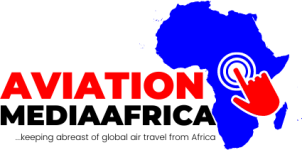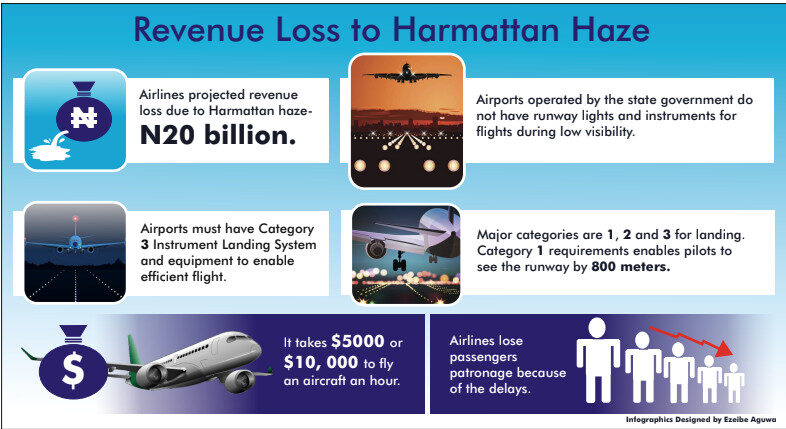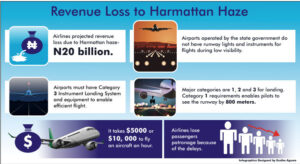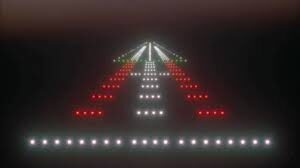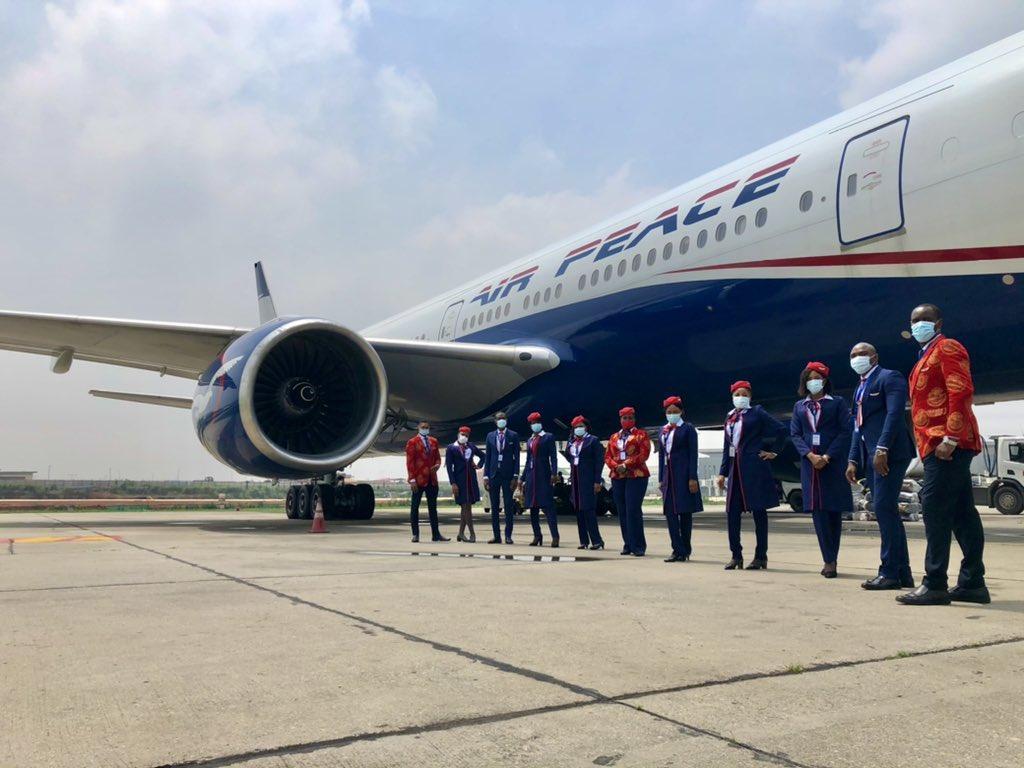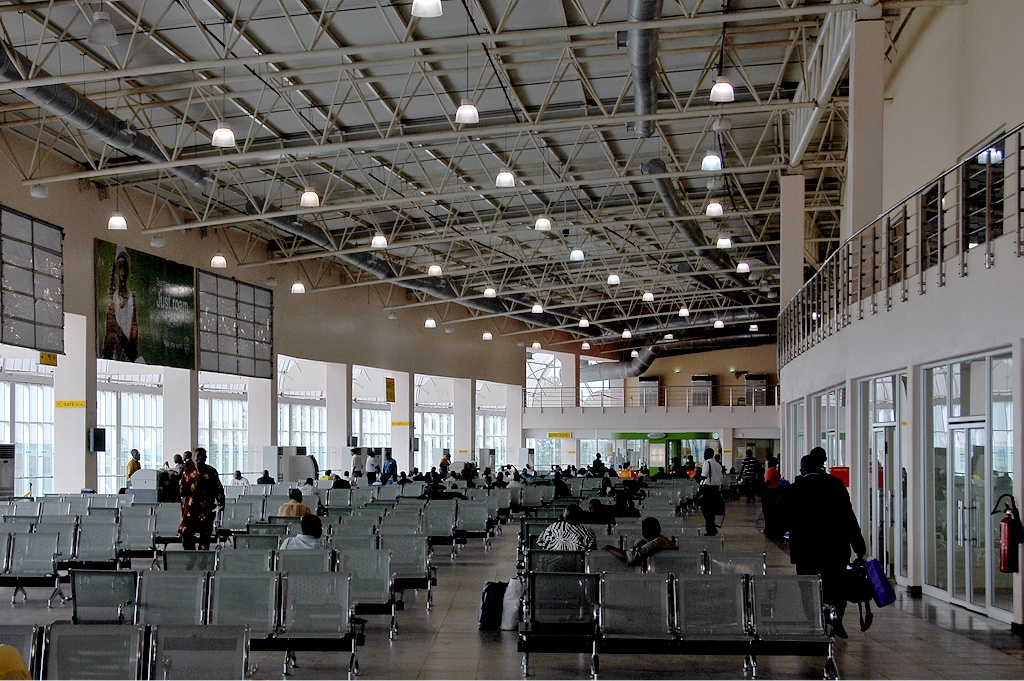Harmattan haze will disrupt flight operations starting from late November to end of January 2026 with projected revenue loss of about N20 billion during the period, which is the peak of flight operations in Nigeria.
This is because like in the previous years, no effort has been made to provide equipment that will counter the effect of harmattan on flight operations in Nigeria.
It was learnt that many of the airports operated by the state government do not have runway lights and other necessary instruments that can enable flights operate during low visibility both in the day and in the night.
Also, some of the airports operated by the Federal Airports Authority of Nigeria (FAAN) do not have enabling facilities that could allow flight operations during unfavourable weather occasioned by the harmattan haze.
Experts predicts that the industry will witness flight cancellations, unruly passenger behaviour, over stretched airport facilities, as airlines struggle to use the window of limited safe weather conditions to operate flights to airlift thousands of passengers who travel for holiday during the period.
Over the years, it has been hoped that harmattan would be made to have negligible effect on flight operations, as the federal government promised at different administrations that it would provide the needed equipment that could enable flights operate at low visibility, but this has not happened; so, airlines must brace up for the flight disruptions and huge loss of revenue during the inimical weather conditions.
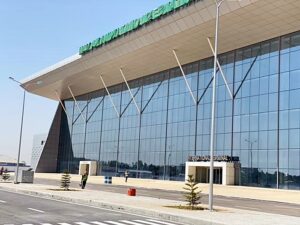
For flights to land and depart at low visibility due to harmattan, an airport must have Category 3 Instrument Landing System with all the associated equipment that will enable it to work efficiently.
A former Managing Director of the Nigerian Airspace Management Agency (NAMA), Matthew Pwajok, gave details of what happens during the harmattan period.
According to him, “Weather is not what anybody can change; it must come when it will come but the only way to tame its adverse effects is to use other means to manage it and in aviation, it is infrastructure.”
Pwajok said that airlines spend a lot of money when they divert or cancel flights due to harmattan haze and other factors.
“An airline knows how much it costs to fly an aircraft for an hour. If it is $5000 or $10, 000 to fly an aircraft an hour, airlines know the cost of hiring one aircraft. Airlines know the payments they make for landing and for take-off and they also know the fuel they burn. So, when you have a one hour flight and then you return back making two hours, and let’s say you are burning fuel of $5000 for a one hour flight, that is $5000 plus another $5000, that is $10,000. Then the passengers that you have lost their patronage because of the delays, the goodwill you have lost, the refunds you have to make, people that you might have to take to a hotel or transporting them or feeding them, all these are costs. So, it definitely costs an airline a lot to divert a flight. And so, it is something that can be minimised if all the equipment and facilities are put in place,” he said.
He said such critical equipment must be available during the day and in the night because low visibility can occur at any time.
To forestall flight disruption towards the end of the year, Pwajok said state governments that run airports and FAAN can provide some of the equipment to alleviate the impact of bad weather during the Yuletide.
Pwajok also explained that airports that do not have the necessary requirements for night landing and low visibility usually shut down in order to discourage flights to risk landing at such airports.
According to the former NAMA boss, in order to enhance visibility and to enable approach and landing, the agency must provide Voice Omnidirectional Radio Range (VOR), which is the basic equipment that brings the aircraft down; “then the Instrument Landing System that guide the aircraft vertically, longitudinally and horizontally and this equipment must be calibrated and available to enable aircraft approach and land. This and Distance Measuring Equipment (DME) must be available to enable aircraft land in low visibility.
“So, the instrument landing system must be available and it must also be calibrated. Calibrated means it is tested. It is accurate. It has integrity and it is reliable and it is available for approach and landing. So those aspects of the instrument landing system under NAMA must be there.”
“Then it also goes with what we call a distance measuring equipment which is part of the instrument landing system. So, it should also be available. Once NAMA has an instrument landing system or the state government has an instrument landing system for that runway and it is calibrated, then of course operations at night can be assured. Now I need to also talk about the category of the instrument landing system,” Pwajok said.
According to him, there could be instrument landing system at an airport but the capacity of it would determine the category and how it can perform in low visibility.
He said that the major categories are 1, 2 and 3 for landing, but category 1, is the basic instrument for landing system category.
“Category 1 requires that you should be able to see the runway by 800 meters. That is when the reported visibility by NIMET (Nigeria Meteorological Agency) is 800 meters, then you can use a category 1. When visibility deteriorates below 800 meters, then you will be talking about category 2. So once visibility is less than 800 meters, a category 1 instrument landing system, even if you have it in the airport, you can’t use it to land. So, the airline may still tell you they can’t land because the minimum is lower than what is available. The category 2 is basically what we have in most airports in Nigeria,” Pwajok said.
Pwajok explained, “Now, when you start talking about visibility below, maybe, 300 meters, then you will be thinking of category 3 ILS, which is not exactly operational even though we have it in Lagos and Abuja. And we are already procuring for Kano, Port Harcourt. But the main thing that is making it not to be operational is the lighting system. The lighting system at this airport is category 2. And that is why NAMA even though installed category 3 ILS, they had to use it as category 2. Because the perimeter fencing, the birds and wildlife control, and then the lighting system did not meet the requirement for category 3 Instrument Landing System. So even though NAMA has it, airlines can’t run it because you have to ensure there is no incursions by animals.”
Also, Head of Central Forecast Officer (CFO), NIMET, Wasiu Adeniyi Ibrahim, told THISDAY that airlines are not supposed to operate below 300 meters weather minima and because commercial airlines carry passengers they have to be more careful and will not risk visibility below 300 meters.
He also noted that now that there are efficient weather reports for three days, travellers can decide to travel at the period of clement weather conditions, adding that even when the on the ground weather equipment is provided, some aircraft may not have on-board equipment to receive the needed signals.
So, until FAAN and NAMA provide the required landing equipment like Category 3 ILS and fully lighted runway to meet the specifications, harmattan will continue to be a menace to flight operations in Nigeria.
